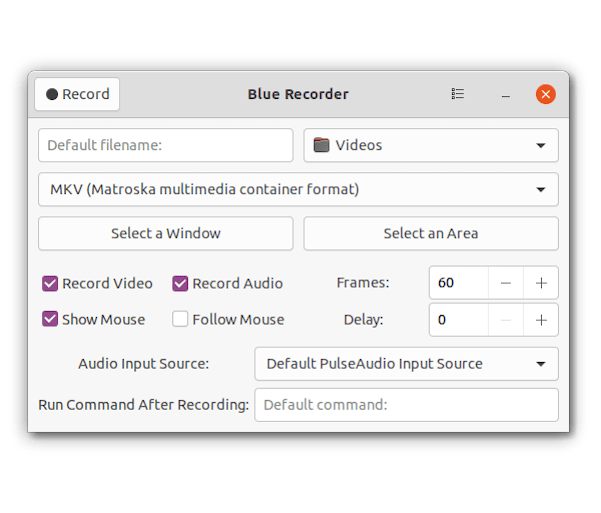How To Install Blue Recorder on Ubuntu 24.04 LTS

In this tutorial, we will show you how to install Blue Recorder on Ubuntu 24.04 LTS. Screen recording capabilities are essential for creating tutorials, demonstrating software features, or documenting bugs on Ubuntu 24.04 LTS. Blue Recorder stands out as an elegant, lightweight solution for capturing screen activity without consuming excessive system resources. This comprehensive guide will walk you through installing and configuring Blue Recorder on Ubuntu 24.04 LTS, providing you with the knowledge to create high-quality screen recordings.
What is Blue Recorder?
Blue Recorder is a simple yet powerful screen recording application designed specifically for Linux systems. It was developed as a continuation of the Green Recorder project but completely rewritten in Rust for improved performance and reliability. Released under the GNU General Public License v3, Blue Recorder exemplifies the open-source philosophy that drives Linux development.
This lightweight tool leverages Rust, GTK+3, and ffmpeg to deliver smooth recording capabilities. Blue Recorder supports an impressive range of output formats, including mkv, avi, mp4, wmv, gif, and nut, giving users flexibility in how they save their recordings.
One of Blue Recorder’s most notable features is its native support for both Wayland and Xorg display servers, making it particularly valuable for Ubuntu 24.04 LTS users who might be using either display server technology.
Why Choose Blue Recorder for Ubuntu 24.04?
Ubuntu 24.04 LTS users have several screen recording options available, but Blue Recorder offers distinct advantages:
Lightweight Design: Blue Recorder consumes minimal system resources during recording sessions, ensuring your computer remains responsive even when capturing resource-intensive applications.
User-Friendly Interface: Blue Recorder features an intuitive, straightforward interface that doesn’t overwhelm users with unnecessary options. Within moments of launching the application, even beginners can configure and start recording without navigating complex menus.
Format Flexibility: Whether you need high-quality MKV files for editing, universally compatible MP4 files for sharing, or animated GIFs for quick demonstrations, Blue Recorder accommodates your needs without requiring additional conversion tools.
Wayland Compatibility: With native support for Wayland, Blue Recorder works seamlessly with Ubuntu 24.04’s default display server, unlike some other recording tools that struggle with Wayland sessions.
Customization Options: Blue Recorder allows you to select specific recording areas, choose audio input sources, adjust frame rates, and set custom save locations.
Pre-Installation Requirements
Before installing Blue Recorder, ensure your system is properly prepared:
- Verify Ubuntu Version: Confirm you’re running Ubuntu 24.04 LTS with:
lsb_release -a - Update System Packages: Ensure all existing packages are up to date:
sudo apt update sudo apt upgrade - Check Disk Space: Blue Recorder itself requires minimal space, but your recordings might need substantial storage depending on length and quality.
- Internet Connection: A stable internet connection is necessary to download Blue Recorder and its dependencies.
- Administrative Access: You’ll need sudo privileges to install packages.
Method 1: Installing Blue Recorder via Snap
Snap is a package management system developed by Canonical and comes pre-installed on Ubuntu 24.04 LTS.
Updating Snap
First, ensure your Snap system is up to date:
sudo snap refreshThis command updates Snap itself and any installed Snap packages.
Installing Blue Recorder
With Snap prepared, install Blue Recorder by executing:
sudo snap install blue-recorderThis command downloads and installs the latest stable version of Blue Recorder from the Snap Store.
Configuring Permissions
Blue Recorder requires specific permissions to function correctly. Connect the necessary interfaces with:
sudo snap connect blue-recorder:audio-record :audio-record
sudo snap connect blue-recorder:screencast-legacy :screencast-legacyThese commands grant Blue Recorder permissions to record audio and capture your screen.
Verifying Installation
Confirm successful installation by searching for “Blue Recorder” in the Applications menu or launching it from the terminal:
blue-recorderIf the application launches without errors, you’ve successfully installed Blue Recorder via Snap.
Troubleshooting Snap Installation
If you encounter issues:
- Permission Errors: Ensure you’re using
sudowith installation commands. - Connection Issues: Check your internet connection.
- Missing Interfaces: If the application launches but can’t record, verify you’ve connected the required interfaces.
- Snap Store Access: Ensure snap support is enabled in your Desktop store.
Method 2: Installing Blue Recorder via Flatpak
Flatpak offers an alternative installation method that sometimes provides more up-to-date versions. Unlike Snap, Flatpak isn’t pre-installed on Ubuntu 24.04 LTS.
Installing Flatpak
Install Flatpak on your system:
sudo apt install flatpakAdding the Flathub Repository
Add Flathub, the primary repository for Flatpak applications:
sudo flatpak remote-add --if-not-exists flathub https://flathub.org/repo/flathub.flatpakrepoAfter adding the repository, reboot your system for changes to take effect:
sudo rebootInstalling Blue Recorder
With Flatpak and Flathub configured, install Blue Recorder:
sudo flatpak install flathub sa.sy.bluerecorderDuring installation, you’ll be prompted to confirm the installation of Blue Recorder and its dependencies.
Verifying Flatpak Installation
Confirm successful installation by searching for “Blue Recorder” in the Applications menu or launching it from the terminal:
flatpak run sa.sy.bluerecorderIf the application starts without errors, you’ve successfully installed Blue Recorder via Flatpak.
When to Choose Flatpak Over Snap
Consider using Flatpak if:
- You prefer the latest version of Blue Recorder.
- You’re experiencing compatibility issues with the Snap version.
- You already use other Flatpak applications and prefer consistency.
- You need better integration with certain desktop environments.
Launching and Initial Setup
After installation, familiarize yourself with launching and configuring the application.
Finding and Launching Blue Recorder
Launch Blue Recorder through the Applications menu:
- Open the Applications overview (press the Super/Windows key)
- Type “Blue Recorder” in the search field
- Click on the Blue Recorder icon
Alternatively, launch from the terminal:
- If installed via Snap:
blue-recorder - If installed via Flatpak:
flatpak run sa.sy.bluerecorder

Understanding the Interface
When first launched, Blue Recorder presents a straightforward interface with these key elements:
- Format Selection: Choose your preferred recording format
- Recording Area: Select full screen or a specific area
- Audio Input: Choose your preferred audio source
- Frames: Adjust the frame rate
- Delay: Set a countdown delay before recording begins
- Record Button: Start recording once settings are configured
Configuring Blue Recorder
Blue Recorder offers various configuration options to customize your recording experience.
Setting Output File Format
Select from multiple output formats:
- MKV: Excellent quality and compression
- MP4: Widely compatible format
- AVI: High quality but larger file size
- WMV: Compatible with Windows systems
- GIF: Animated image format for short clips
- NUT: Raw format with minimal processing
Configuring Recording Area
Record either your entire screen or a specific area:
- From the main interface, select either “Full Screen” or “Select Area”
- If choosing “Select Area,” click and drag to define the recording region
Recording a specific area is useful when focusing on a particular application without capturing unnecessary screen elements.
Selecting Audio Input Source
For recordings with audio:
- Click the “Audio Input” dropdown menu
- Select your preferred audio source
- To record without audio, select “Disabled”
Frame Rate and Quality Settings
Adjust the frame rate based on your needs:
- Higher frame rates (30+ FPS) produce smoother video but create larger files
- Lower frame rates (15-20 FPS) are suitable for most desktop applications
- For gaming, aim for 30-60 FPS
Setting Save Location
Change where recordings are saved:
- Click the folder icon in the interface
- Navigate to your preferred save location
- Click “Select” to confirm
Delay Timer Configuration
Set a countdown before recording begins:
- Set your desired delay in seconds
- When starting recording, Blue Recorder will count down
- Recording begins automatically once the countdown completes
Saving Default Preferences
Blue Recorder automatically saves your configuration between sessions:
- Configure all settings as desired
- Close Blue Recorder
- Your settings will be restored next time you launch the application
Recording Your First Screen Capture
With configuration complete, you’re ready to create your first recording.
Preparing Your Desktop
Before starting:
- Close unnecessary applications
- Organize windows and content
- Consider disabling notifications
- If recording with audio, check your microphone
Starting the Recording Process
To begin recording:
- Launch Blue Recorder
- Configure your desired settings
- Click the “Record” button
- If you set a delay, wait for the countdown
- Once recording begins, Blue Recorder minimizes to the notification area
Visual Indicators During Recording
While recording:
- A red recording icon appears in your notification area
- Hovering over this icon displays the recording duration
Methods to Stop Recording
When ready to end your recording:
- Right-click the recording icon and select “Stop Recording”
- Middle-click the recording icon (works on most desktop environments)
- Launch Blue Recorder again and click “Stop”
Blue Recorder automatically saves your file to the designated location.
Accessing and Playing Your Recorded Files
After stopping:
- Blue Recorder displays a notification with a “Play” button
- Clicking “Play” opens the recording in your default video player
- Alternatively, navigate to your save location to find the file
Advanced Usage Tips
After mastering the basics, explore these advanced techniques.
Keyboard Shortcuts for Efficient Workflow
Improve efficiency by:
- Creating custom keyboard shortcuts to launch Blue Recorder
- Using desktop environment shortcuts to quickly access the notification area
- Utilizing your video player’s keyboard shortcuts when reviewing recordings
Optimizing Quality vs. File Size
Balance quality and file size by:
- Using MP4 format with moderate frame rates for most tutorials
- Selecting MKV for higher quality when file size isn’t a concern
- Choosing GIF only for very short clips without audio
- Recording only the necessary screen area
Best Practices for Different Recording Scenarios
Adapt settings for different use cases:
- Software Tutorials:
- Record at 1080p or lower
- Use 15-20 FPS
- Consider recording with microphone audio only
- Gaming:
- Use MKV format
- Set 30-60 FPS
- Record full screen
- Presentations:
- Record the presentation window only
- Use moderate compression
- Ensure clear audio if narrating
Audio Synchronization Tips
To maintain proper audio-video sync:
- Close resource-intensive applications
- Use a consistent frame rate
- Test audio levels before starting
- If experiencing desync, try recording at a lower resolution or frame rate
Troubleshooting Common Issues
Solutions to common problems:
Audio Recording Problems
If experiencing audio issues:
- Verify the correct audio input is selected
- Check system sound settings
- For Snap installations, confirm audio-record permissions are connected
- Consider using a dedicated microphone for better quality
Video Quality Issues
For video quality problems:
- Increase recording resolution if possible
- For text-heavy content, avoid excessive compression
- Record only the necessary area for higher detail
- Try a different output format
Performance Lag During Recording
If your system slows down during recording:
- Reduce the recording resolution and frame rate
- Close unnecessary applications
- Try recording to a different storage drive
- Disable desktop effects
- Use a more efficient output format like MKV
Updating Blue Recorder
Keep Blue Recorder updated for the latest features and bug fixes.
Updating via Snap
Update Blue Recorder installed via Snap with:
sudo snap refresh blue-recorderOr update all Snap packages:
sudo snap refreshUpdating via Flatpak
For Flatpak installations:
sudo flatpak update sa.sy.bluerecorderOr update all Flatpak applications:
sudo flatpak updateUninstalling Blue Recorder
If needed, remove Blue Recorder from your system.
Removal via Snap
Uninstall Blue Recorder installed via Snap:
sudo snap remove blue-recorderRemoval via Flatpak
For Flatpak installations:
sudo flatpak uninstall sa.sy.bluerecorderCongratulations! You have successfully installed Blue Recorder. Thanks for using this tutorial for installing the Blue Recorder simple desktop recorder on Ubuntu 24.04 LTS system. For additional help or useful information, we recommend you check the official Blue Recorder website.